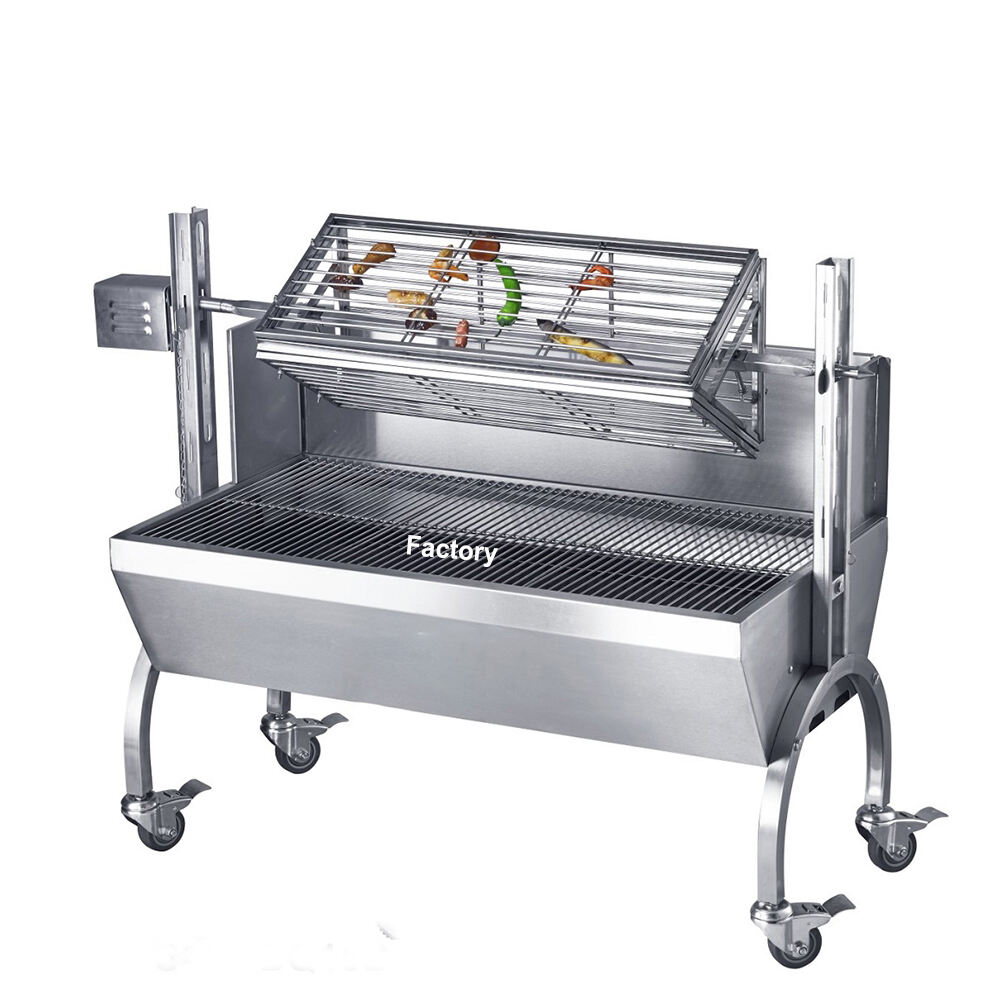Რა არის ბარბეკიუ მანქანების სხვადასხვა ტიპი და მათი სარგებელი?
Თქვენთვის სრულყოფილი ბარბეკიუ მანქანის ზომის შესარჩევად აუცილებელი ფაქტორები
Სწორი ზომის ბარბეკიუ მანქანის შერჩევა შეიძლება განსხვავებულიყო დამახსოვრებელი გარე შეკრებების მასპინძლობასა და შემზარებელი სამზარე შეზღუდვების მოგვარებას შორის. თუ თქვენ ის ხართ, ვინც სასიამოვნოდ ატარებს დროს ან ის ვინც ისიამოვნებს პატარა ოჯახური სადილებს ღია ცის ქვეშ, სწორი ზომის ბარბეკიუ მანქანის შერჩევის გაგება არის აუცილებელი თქვენთვის გარე სამზარე წარმატებისთვის. ეს სრულად განვითარებული მარშრუტი დაგეხმარებათ გაერკვით სხვადასხვა ფაქტორში, რასაც უნდა იგულისხმოთ თქვენთვის სრულყოფილი ზომის გრილის არჩევისას.
Ბარბეკიუ მანქანის ზომებისა და სამზარე სივრცის გაგება
Ძირითადი სამზარე არეალის ზომები
Სამზარე სივრცე არის მთავარი გრილის ზედაპირი, სადაც მზარეულობს უმეტესად ამზადებენ. შეფასებისას Ბარბაქი ზომა, პირველ რიგში მიაქციეთ ყურადღება მთავარ მზარეულის ზედაპირზე, რომელიც საჭიროა კვადრატული ინჩებით გასაზომად. საშუალო ზომის გრილს ჩვეულებრივ გთავაზობთ 400-500 კვადრატული ინჩის მთავარი მზარეულის სივრცე, რომელიც შეიძლება შეგიძლოთ შესახებ 20 ჰამბურგერი ერთდროულად. დიდი გრილები შეიძლება მოგცეთ 700 კვადრატული ინჩი ან მეტი, განსაკუთრებით დიდი შეკრებებისთვის, ხოლო კომპაქტური მოდელები შეიძლება გთავაზობთ 300 კვადრატული ინჩი, საუკეთესო პატარა ოჯახებისთვის.
Მეორეული მზარეულის ზონები და გათბობის რეშები
Ბევრი მარილის მოწყობილობა აქვს დამატებითი სამზარე სივრცეები, როგორიცაა საცხელე რეშეტკები ან მეორეხარისხოვანი მზარეულის ზონები. ეს სივრცეები ამატებს სამზარო ვარიანტების სიმრავლეს და უნდა გაითვალისწინოთ საჭირო საერთო ბარბეკიუ მარილის ზომის განსაზღვრისას. საცხელე რეშეტკები შესანიშნავია პურის გასაცხელებლად, საჭმლის ცხელი შენახვისათვის ან ნაზი საგნების დაბალ ტემპერატურაზე მზარეულისთვის. ეს მეორეხარისხოვანი ზონები შეიძლება გაზარდოს თქვენი საერთო მზარეულის სივრცე 100-200 კვადრატული ინჩით, რაც უზრუნველყოფს დამატებით სივრცეს დასავლებული მზარეულის სესიების დროს.
Მარილის ზომის შესაბამისობა თქვენი ცხოვრების წესთან
Ოჯახის ზომის გათვალისწინება
Თქვენი ოჯახის ზომა მნიშვნელოვან როლს ასრულებს ბარბეკიუს გრილის შესაბამისი ზომის განსაზღვრაში. ოთხი ადამიანისგან შემდგარი ოჯახისთვის, როგორც წესი, საკმარისია 400-500 კვადრატული დიუიმი პირველადი სამზადებლად, რათა ყოველდღიური სადილის მომზადება შეძლოთ. ეს საშუალებას გაძლევთ ერთდროულად რამდენიმე სამზადებლად მოამზადოთ, ხოლო საკვებს შორის შენარჩუნდეს შესაბამისი მანძილი. უფრო დიდი ოჯახები ან ისინი, ვინც ხშირად ამზადებენ სტუმრებისთვის, შეიძლება განიხილონ 600+ კვადრატული დიუიმის მქონე გრილები, რათა თავიდან აიცილონ სამზადებლო ნამდვილის მიხედვით მომზადება.
Გართობისა და სოციალური შეკრებების საჭიროებები
Თუ ხშირად ატარებთ მიწის სახლში პარტიებს ან მეზობლების შეკრებებს, მაშინ თქვენი ბარბეკიუ მანქანის ზომის საჭიროებები მნიშვნელოვნად განსხვავდება იმ ადამიანისგან, ვინც ძირითადად საოჯახო საღამოებისთვის მზადობს საჭმელს. გაითვალისწინეთ, თუ რამდენად ხშირად ატარებთ სტუმრებს და რამდენად დიდია თქვენი შეკრებების საშუალო ზომა. ხშირად გასართობებისთვის, დიდი მანქანა 700+ კვადრატული დინების სამზარე სივრცით საშუალებას გაძლევთ 15-20 ადამიანისთვის საჭმლის მომზადებაში ეფექტურად. გახსოვდეთ, რომ სამზარე პარტიებად მომზადება დროში ხარჯიანია და შეიძლება შეგიზღუდოთ იმით, რომ თავად არ შეძლოთ სტუმრებთან ერთად გაქვთ დრო.
Სივრცე და შენახვის მოთხოვნები
Მისაწვდომი პატიოს ან დეკის სივრცე
Სანამ ბარბეკიუს მარილის ზომას შეარჩევთ, ყურადღებით გაზომეთ თქვენი გარე სივრცე. გახსოვდეთ, რომ გარკვეული უსაფრთხოების ინტერვალი გამოიცალოთ მარილის გარშემო – სტანდარტულად 3 ფუტი ნებისმიერი სტრუქტურიდან ან აალებადი მასალებიდან. გაითვალისწინეთ მარილის ფართობი, როდესაც მისი მარჯვენა გვერდი ღიაა და დარწმუნდით, რომ ყველა მხრიდან გაქვთ კომფორტული სივრცე. დიდი მარილი შეიძლება შემოგთავაზოთ შესანიშნავი სამზარე ტევადობა, მაგრამ თუ ის ძალიან დიდია თქვენი პატიოსთვის ან ქმნის უსაფრთხოების საფრთხეს, ეს არ არის სწორი არჩევანი.
Შენახვისა და დაცვის ასპექტები
Ფიქრობდით, სად შეინახავდით ან დაიცავდით მარილს გამოყენების დროს. თუ გეგმები გაქვთ მარილის შენახვის ან ამინდის დაცვის მიზნით გადაადგილებაზე, დარწმუნდით, რომ მისი ზომა საშუალებას გაძლევთ ის იოლად გადაიტანოთ კიბეებში ან მრუდებში. ზოგიერთი უფრო დიდი მარილის შესანახად შესაძლოა მომხმარებელმა მუდმივი ადგილი მიუთითოს კარგი საფარით, ხოლო პატარა მოდელები სთავაზობენ უფრო მეტ არჩევანს შენახვის ვარიანტებში. გაითვალისწინეთ თქვენი კლიმატი და დაცული სივრცე, როდესაც განსაზღვრავთ მაქსიმალურ ბარბეკიუს მარილის ზომას, რომელიც თქვენთვის პრაქტიკულია.

Სამზარეულოს სტილი და საჭიროებების მრავალფეროვნება
Რამდენიმე სამზარეულოს ზონა
Სხვადასხვა ბარბეკიუ მანქანის ზომები გვაძლევს საშუალებას შევქმნათ განსხვავებული მზარეულის ზონები. უფრო დიდი მანქანები უზრუნველყოფს საშუალებას რომ მოვაწყოთ სხვადასხვა ადგილი პირდაპირი და არაპირდაპირი მზარეულისთვის, რაც საშუალებას გვაძლევს ერთდროულად მოვამზადოთ სხვადასხვა სახის საჭმელი სხვადასხვა ტემპერატურაზე. ეს განსაკუთრებით მნიშვნელოვანია იმ საგნების მზარეულის დროს, რომლებიც სხვადასხვა მეთოდს მოითხოვენ, მაგალითად, სტეიკის დამარცვლისას და ნელა მზარეული ქათმის ან ბოსტნეულის დროს. 500 კვადრატული დინჯის მინიმუმი ხშირად საკმარისია ზონების მოწყობისთვის.
Სპეციალური შესაძლებლობები და აქსესუარები
Გაითვალისწინეთ, თუ როგორ შეიძლება დამატებითი შესაძლებლობების გავლენა იმოქმედოს ბარბეკიუ მანქანის საჭიროების ზომაზე. გვერდითი გამახურებელი მოწყობილობები, როტისერის სისტემები ან მოხლების ყუთები შეიძლება გაზარდოს მანქანის სრულ ზომას, რათა მიეწიოს გაფართოებული მზარეულის ვარიანტები. დარწმუნდით, რომ არჩეული მანქანის ზომა შეესაბამება იმ შესაძლებლობებს, რომლებსაც თქვენ ხშირად იყენებთ, არ დაზარალდეს ძირითადი მზარეულის ადგილი და არ შექმნას არახელსაწყო მზარეულის სივრცე.
Გრილის არჩევანი მომდევნო გამოყენებისთვის
Ზრდა და გატარება
Როდესაც აირჩევთ ბარბეკიუ გრილის ზომას, გაითვალისწინეთ შესაძლო ცვლილებები თქვენი გრილის საჭიროებებში დროის გასვლისთან. თუ გეგმავთ ოჯახის გაფართოებას ან მსხვილი შეკრებების მოწყობას მომდევნო წელზე, ამ წელს უფრო დიდი გრილის არჩევა უფრო ხარჯთაღნიანი იქნება ვიდრე მომდევნო განახლება. თუმცა, შეაფასეთ ეს მიმდინარე პრაქტიკული ასპექტების და ბიუჯეტის გასაღებთან.
Გრძელვადიანი ღირებულება და გამოყენება
Სწორი ბარბეკიუ გრილის ზომის შეძენა შეიძლება მოგცეს წელზე მეტი სასიამოვნო გარე სივრცეში სამზარეულოს გამოცდილება. მიუხედავად იმისა, რომ უფრო დიდი გრილები საწყისად უფრო მეტ თანხას მოითხოვს, ისინი სთავაზობენ უფრო მეტ მრავალფეროვნებას და ტევადობას, რაც შეიძლება გამართლებული იყოს ინვესტიცია. გაითვალისწინეთ თუ როგორ შეიძლება ევოლუციონირება თქვენი სამზარეულოს ჩვევების და აირჩიეთ ზომა, რომელიც შეესაბამება როგორც მიმდინარე ასევე მომდევნო საჭიროებებს ენერგიის დამატებითი დანახარჯის ან გამოუყენებელი სივრცის გარეშე.
Ხშირად დასმული კითხვები
Რა არის იდეალური ბარბეკიუ გრილის ზომა სამი ადამიანიანი ოჯახისთვის?
Ოთხ პიროვანი ოჯახისთვის, ჩვეულებრივ, იდეალურია 400-500 კვადრატული ინჩის მთავარი სამზარე სივრცის მქონე მანქანა. ასეთი ზომის მანქანა საშუალებას გაძლევთ ერთდროულად მოამზაროთ 12-16 ჰამბურგერი ან სრულყოფილი საღამოს სამზარე კომპონენტების კომბინაცია.
Რამდენ სივრცეს უნდა დატოვო ჩემს მანქანს შემოვლით უსაფრთხოებისთვის?
Მანქანის გარშემო სტრუქტურებისაგან, კედლებისაგან ან აალებადი მასალებისაგან ყველა მხრიდან მინიმუმ სამი ფუტის გასუფთავება შეინარჩუნეთ. ასევე უზრუნველყავით საკმარისი სივრცის მოწყობა ზემოდან, განსაკუთრებით მაშინ, თუ მანქანა მოთავსებულია დახურულ ადგილში.
Შეიძლება თუ არა უფრო დიდი ბარბეკიუს მანქანის გამოყენება პატარა სამზარე საღამოებისთვის?
Დიახ, უფრო დიდი მანქანები შეიძლება გამოვიყენოთ პატარა სამზარე საღამოებისთვის მხოლოდ სამზარე ზედაპირის ნაწილის გამოყენებით და ცალკე გათბობის ზონების შექმნით. თუმცა, ისინი შეიძლება გამოიყენონ მეტი საწვავი და უფრო გრძელი დრო დასჭირდეს გათბობისთვის პატარა მანქანებთან შედარებით.







